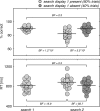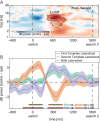Priority Switches in Visual Working Memory are Supported by Frontal Delta and Posterior Alpha Interactions
- PMID: 30215669
- PMCID: PMC6188546
- DOI: 10.1093/cercor/bhy223
Priority Switches in Visual Working Memory are Supported by Frontal Delta and Posterior Alpha Interactions
Abstract
Visual working memory (VWM) distinguishes between representations relevant for imminent versus future perceptual goals. We investigated how the brain sequentially prioritizes visual working memory representations that serve consecutive tasks. Observers remembered two targets for a sequence of two visual search tasks, thus making one target currently relevant, and the other prospectively relevant. We show that during the retention interval prior to the first search, lateralized parieto-occipital EEG alpha (8-14 Hz) suppression is stronger for current compared with prospective search targets. Crucially, between the first and second search task, this difference in posterior alpha lateralization reverses, reflecting the change in priority states of the two target representations. Connectivity analyses indicate that this switch in posterior alpha lateralization is driven by frontal delta/low-theta (2-6 Hz) activity. Moreover, this frontal low-frequency signal also predicts task performance after the switch. We thus obtained evidence for large-scale network interactions underlying the flexible shifting between the priority states of multiple memory representations in VWM.
Figures





Similar articles
-
Posterior α EEG Dynamics Dissociate Current from Future Goals in Working Memory-Guided Visual Search.J Neurosci. 2017 Feb 8;37(6):1591-1603. doi: 10.1523/JNEUROSCI.2945-16.2016. Epub 2017 Jan 9. J Neurosci. 2017. PMID: 28069918 Free PMC article.
-
Decoding the status of working memory representations in preparation of visual selection.Neuroimage. 2019 May 1;191:549-559. doi: 10.1016/j.neuroimage.2019.02.069. Epub 2019 Mar 3. Neuroimage. 2019. PMID: 30840904
-
Local and interregional alpha EEG dynamics dissociate between memory for search and memory for recognition.Neuroimage. 2017 Apr 1;149:114-128. doi: 10.1016/j.neuroimage.2017.01.031. Epub 2017 Jan 26. Neuroimage. 2017. PMID: 28132933
-
Searching for auditory targets in external space and in working memory: Electrophysiological mechanisms underlying perceptual and retroactive spatial attention.Behav Brain Res. 2018 Nov 1;353:98-107. doi: 10.1016/j.bbr.2018.06.022. Epub 2018 Jun 26. Behav Brain Res. 2018. PMID: 29958962
-
Oscillatory Control over Representational States in Working Memory.Trends Cogn Sci. 2020 Feb;24(2):150-162. doi: 10.1016/j.tics.2019.11.006. Epub 2019 Nov 29. Trends Cogn Sci. 2020. PMID: 31791896 Review.
Cited by
-
An EEG-Based Investigation of the Effect of Perceived Observation on Visual Memory in Virtual Environments.Brain Sci. 2022 Feb 15;12(2):269. doi: 10.3390/brainsci12020269. Brain Sci. 2022. PMID: 35204033 Free PMC article.
-
Visual working memory recruits two functionally distinct alpha rhythms in posterior cortex.eNeuro. 2022 Sep 27;9(5):ENEURO.0159-22.2022. doi: 10.1523/ENEURO.0159-22.2022. Online ahead of print. eNeuro. 2022. PMID: 36171059 Free PMC article.
-
Current and future goals are represented in opposite patterns in object-selective cortex.Elife. 2018 Nov 6;7:e38677. doi: 10.7554/eLife.38677. Elife. 2018. PMID: 30394873 Free PMC article.
-
A Review of EEG and fMRI Measuring Aesthetic Processing in Visual User Experience Research.Comput Intell Neurosci. 2021 Dec 16;2021:2070209. doi: 10.1155/2021/2070209. eCollection 2021. Comput Intell Neurosci. 2021. PMID: 34956344 Free PMC article. Review.
-
Allocation of resources in working memory: Theoretical and empirical implications for visual search.Psychon Bull Rev. 2021 Aug;28(4):1093-1111. doi: 10.3758/s13423-021-01881-5. Epub 2021 Mar 17. Psychon Bull Rev. 2021. PMID: 33733298 Free PMC article. Review.
References
-
- Alekseichuk I, Turi Z, De Lara A, Antal A, Alekseichuk I, Turi Z, De Lara GA, Antal A, Paulus W. 2016. Spatial working memory in humans depends on theta and high gamma synchronization in the prefrontal cortex article spatial working memory in humans depends on theta and high gamma synchronization in the prefrontal cortex. Curr Biol. 26:1513–1521. - PubMed
-
- Bonnefond M, Jensen O. 2012. Alpha oscillations serve to protect working memory maintenance against anticipated distracters. Curr Biol. 22:1969–1974. - PubMed
-
- Bundesen C. 1990. A theory of visual attention. Psychol Rev. 97:523–547. - PubMed
-
- Buzsáki G, Draguhn A. 2004. Neural oscillations in cortical networks. Sci. 304: 1926–1929. - PubMed
Publication types
MeSH terms
LinkOut - more resources
Full Text Sources
Other Literature Sources

